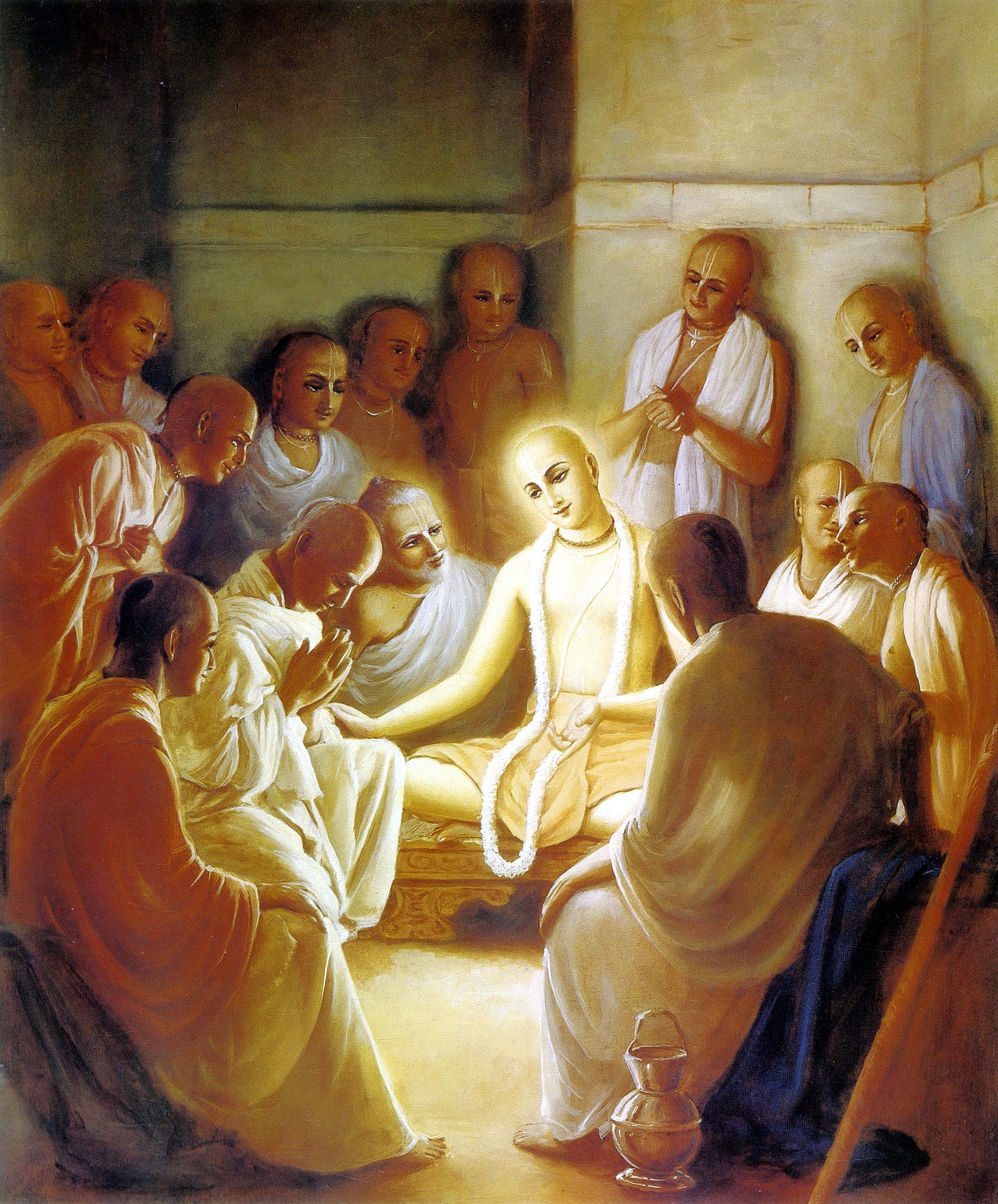The conclusion of the Vedas
Understanding that it would be practically impossible for people of our age to properly study the full Vedic literature, Vyasadeva compiled the most important parts in the Upaniṣads.
The Vedanta-sūtra was compiled by Vyāsadeva as the conclusion of the Vedas. Understanding that it would be practically impossible for people of our age to properly study the full Vedic literature, he compiled the most important parts of the original Vedas in the form of the Upaniṣads, short books that bring the ultimate conclusions of the Vedas, and later wrote the Vedanta-sūtra as a book that offers the ultimate conclusions of the Upaniṣads and clears many common misconceptions. The Vedanta-sūtra brings thus the ultimate philosophical conclusions of the Vedas in an extremely compact form, being composed of about 555 sūtras.
The Vedanta-sūtra starts with the sūtra “athāto brahma-jijñāsā”, Now it’s time to enquire about Brahman.
This is an invitation to properly use our human form of life to try to understand Krsna, the absolute truth, and thus become free of the cycle of birth and death.
It continues with the Sutra “janmādy asya yataḥ”, which starts the description of the Absolute Truth by stating that from Him, everything emanates.
How can we understand this Brahman or the Supreme Absolute truth? This is explained in the third Sutra: “śāstra-yonitvāt”. He can be known through the sastras.
However, the sastras offer different arguments and many of them appear to be contradictory. Somewhere it’s said that Viṣnu is God, somewhere else that Śiva or another demigod is supreme. How can we understand all these apparent contradictions?
This is answered in the 4th sutra: “tat tu samanvayāt”. This Supreme Brahman can be understood by harmonizing the different statements from the sastras.
In other words, we can’t take just one isolated passage as the answer for anything. All passages must be taken inside the context and examined as a single unit if we want to arrive at the right conclusions.
In this way, the Vedanta-sūtra offers a series of conclusions about the Absolute Truth in short, concise aphorisms that need to be very attentively studied.
Often, people think that the Vedanta-sūtra supports the idea that God is impersonal because of the Sariraka-bhasya, the interpretation of Sankaracarya, which became very popular, but that’s not the case. Sankaracarya intentionally covered the real meaning of the Vedanta Sutra with an imaginary interpretation because he had the mission of attracting people from Buddhism back to the Vedas.
The story is that with the beginning of Kali-yuga, people gradually forgot the purpose of the Vedas and started using passages of the scriptures to justify their sinful activities. People became used to eating meat and started justifying the unrestricted killing of animals using passages from the Vedas that speak about animal sacrifices. At this point, Krsna incarnated as Lord Buddha to teach non-violence. He was successful in His mission, but in the process, He had to reject the Vedas, since people insisted on animal killing using the Vedas as support.
As mentioned in the Padma Purana, Sankaracarya is actually an incarnation of Lord Śiva. He came with the mission of re-establishing the authority of the Vedas. For this purpose, he created a philosophy similar to Buddhism that sounded familiar and attractive to people at the time but was based on the Vedas, especially the Vedanta-sūtra. In this way, he brought India back to the Vedas and paved the way for other acaryas, like Madhvacharya, Ramanujacarya, and others, to gradually establish the correct interpretation of the Vedas. This led to a long succession of powerful acaryas, culminating with Sri Caitanya Mahāprabhu. Each brought a part of the ultimate conclusion, leading to the acintya-bhedābheda-tattva philosophy of Mahāprabhu, which brought the ultimate conclusion of the Vedas.
However, the conclusion that God is a person, Krsna, is clear in the Vedanta-sūtra itself. We don’t need to go very far. To illustrate that, I will tell you a small story.
Sri Caitanya Mahāprabhu was able to easily defeat the greatest logicians of His time by just offering a direct and logical interpretation of the Vedanta-sūtra. After his debate with Sri Caitanya Mahāprabhu, Prakāśānanda Sarasvatī, one of the greatest Mayavadis of his time, was forced to admit that:
“Whatever You have said concerning discrepancies in the Māyāvāda philosophy is also known by us. Indeed, we know that all the commentaries on Vedic scriptures by Māyāvādī philosophers are erroneous, especially those of Śaṅkarācārya. Śaṅkarācārya’s interpretations of the Vedānta-sūtra are all figments of his imagination. You have not explained the aphorisms of the Vedānta-sūtra and verses of the Upaniṣads according to Your imagination but have presented them as they are. Thus we are all pleased to have heard Your explanation.”
Later, he added:
“We have given up the actual path of spiritual realization. We simply engage in nonsensical talk. Māyāvādī philosophers who are serious about attaining benediction should engage in the devotional service of Kṛṣṇa, but instead, they take pleasure in useless argument only. We hereby admit that the explanation of Śaṅkarācārya hides the actual import of Vedic literature. Only the explanation given by Caitanya is acceptable. All other interpretations are useless.”
You can also donate using Buy Me a Coffee, PayPal, Wise, Revolut, or bank transfers. There is a separate page with all the links. This helps me enormously to have time to write instead of doing other things to make a living. Thanks!
Read also:
Tat tvam asi: The toothless Mayavada interpretation of the Chandogya Upanisad
Text 3.1.3 of the Mundaka Upanisad brings us an interesting description:




Powerful admission from Prakāśānanda Sarasvatī! Please Sir, are you able to tell us where you learned of this exchange? I would love to be able to cite this.